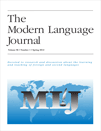
MODERN LANGUAGE JOURNAL
Scope & Guideline
Innovating Language Studies for Tomorrow's Scholars
Introduction
Aims and Scopes
- Empirical Research in Language Acquisition:
The journal publishes studies that provide empirical evidence on various aspects of second language acquisition, including cognitive, social, and emotional factors influencing learning. - Innovative Teaching Methodologies:
There is a strong emphasis on exploring and evaluating new pedagogical approaches, technologies, and instructional materials that enhance language learning outcomes. - Interdisciplinary Perspectives:
The journal integrates insights from linguistics, psychology, sociology, and education to provide a holistic understanding of language learning processes. - Focus on Heritage and Multilingual Education:
A significant area of interest is the education of heritage speakers and multilingual learners, addressing identity, culture, and emotional dimensions in language learning. - Technology in Language Learning:
The incorporation of technology, including digital tools and artificial intelligence, is a recurring theme, reflecting its impact on modern language education. - Teacher Development and Professionalization:
Research on teacher training, professional development, and the emotional experiences of educators forms a core part of the journal's mission.
Trending and Emerging
- Emotion and Language Learning:
Research exploring the emotional dimensions of language learning and teaching is gaining traction, highlighting the importance of affective factors in educational settings. - Technology-Mediated Language Education:
The integration of technology, particularly AI and digital tools, is increasingly prominent, with studies examining their role in enhancing language learning experiences. - Identity and Social Justice in Language Education:
There is a growing emphasis on identity, social justice, and the experiences of marginalized groups in language education, reflecting broader societal movements. - Task-Based Language Learning (TBLT):
TBLT is gaining attention as a preferred approach, focusing on real-world language use and the cognitive and affective factors influencing task performance. - Multimodal and Plurilingual Approaches:
Emerging research highlights the significance of multimodal resources and plurilingual practices in language learning, emphasizing the interplay between different languages and modes of communication.
Declining or Waning
- Traditional Grammar Instruction:
Research focusing solely on traditional grammar instruction methods seems to be waning, as more studies shift towards communicative and context-based approaches. - Bilingual Education without a Cultural Lens:
There is a noticeable decrease in studies that address bilingual education without considering the cultural and emotional contexts of learners, suggesting a shift towards more integrated perspectives. - Static Models of Language Learning:
Static or prescriptive models of language learning are being replaced by dynamic, process-oriented frameworks that better capture the complexities of language acquisition. - Single-Language Focus:
The focus on single-language instruction is declining in favor of more comprehensive studies that examine multilingual contexts and the interactions among multiple languages. - Non-empirical Theoretical Discussions:
There seems to be a reduction in purely theoretical discussions that lack empirical grounding, as the journal increasingly prioritizes research that provides practical insights.
Similar Journals

Guiniguada
Unlocking the potential of education through shared research.Guiniguada is a leading open-access journal established in 2015, published by the University of Las Palmas de Gran Canaria within its Public and Scientific Diffusion Services. With its ISSN 0213-0610 and E-ISSN 2386-3374, the journal provides a platform for innovative research and critical discourse in the field of education sciences, fostering a multidisciplinary approach to educational practices and policies. Situated at the heart of Spain's vibrant academic community, Guiniguada aims to bridge the gap between theoretical frameworks and practical applications, making it an invaluable resource for researchers, educators, and students alike. As an open-access journal, it enhances the global dissemination of knowledge, ensuring that cutting-edge research is freely available to all. The journal's commitment to advancing educational research underscores its significance in shaping contemporary educational practices and influencing policy decisions.

Eurasian Journal of Applied Linguistics
Bridging Cultures Through Language InsightsThe Eurasian Journal of Applied Linguistics, published by Hacettepe University, ELT Department, is a distinguished open-access journal that has been contributing to the fields of linguistics and language education since 2015. With a focus on bridging cultural and linguistic understandings across Eurasia, this journal provides a platform for researchers, educators, and practitioners to share cutting-edge studies, innovative pedagogical strategies, and insightful analyses. The journal holds notable Scopus rankings within the Language and Linguistics (Rank #155/1088, 85th Percentile) and Education (Rank #696/1543, 54th Percentile) categories, evidencing its growing impact within the academic community. As it prepares to converge into a new phase from 2018 to 2024, the Eurasian Journal of Applied Linguistics aims to uphold its mission of fostering interdisciplinary dialogue and advancing knowledge in applied linguistics and its related fields.
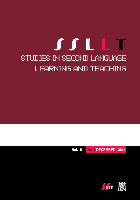
Studies in Second Language Learning and Teaching
Championing open access for global language scholarship.Studies in Second Language Learning and Teaching is a premier open-access journal dedicated to advancing research and scholarship in the fields of education, linguistics, and language acquisition. Published by ADAM MICKIEWICZ UNIVERSITY, KALISZ, this journal has consistently achieved high acclaim, reflected in its impressive Q1 rankings in both Education and Linguistics and Language categories for 2023. With a robust focus on innovative methods, effective pedagogical strategies, and interdisciplinary approaches, Studies in Second Language Learning and Teaching aims to facilitate dialogue among researchers, educators, and practitioners, fostering a deeper understanding of language learning and teaching in diverse contexts. Since its transition to open access in 2011, the journal has expanded its reach, providing valuable resources and research findings to a global audience. With an exceptional Scopus ranking placing it in the top percentiles across multiple categories, this journal stands as a crucial platform for the dissemination of ground-breaking research in second language education.
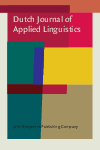
Dutch Journal of Applied Linguistics
Pioneering New Paths in Language StudiesWelcome to the Dutch Journal of Applied Linguistics, a premier open-access publication dedicated to advancing the field of applied linguistics. Published by openjournals.nl and based in the Netherlands, this journal has been committed to disseminating innovative research since its inception in 2012, gaining recognition within the academic community for its rigorous scholarship and high standard of publications. With an impressive Q1 ranking in both the Linguistics and Language category and a commendable percentile standing in Scopus, the journal provides an essential platform for researchers, professionals, and students alike to explore the latest findings and developments in language studies. As an open-access journal since 2021, it ensures that valuable knowledge is freely accessible to a worldwide audience, fostering collaboration and enhancing the impact of research in this dynamic field. The Dutch Journal of Applied Linguistics invites you to contribute and engage with cutting-edge scholarship that shapes the future of language use and learning.

TESL Canada Journal
Bridging Theory and Practice in Language LearningTESL Canada Journal, published by TESL Canada, serves as a vital resource for researchers, educators, and practitioners in the field of English as a Second Language (ESL) and applied linguistics. With its commitment to advancing scholarship and best practices in language education, this esteemed journal fosters a platform for the dissemination of high-quality research and innovative pedagogical approaches. Although it operates without open access, its comprehensive articles and reviews offer valuable insights into current trends and challenges faced by ESL educators across Canada and internationally. The journal is dedicated to promoting a deeper understanding of language acquisition processes and instructional methodologies, contributing significantly to the professional development of its readership. Located in Burnaby, Canada, the journal aims to bridge the gap between theory and practice, making it an indispensable source for educators and researchers looking to enhance their expertise in ESL education.
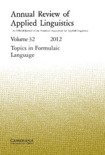
Annual Review of Applied Linguistics
Illuminating insights in language and psychology.The Annual Review of Applied Linguistics, published by Cambridge University Press, stands as a premier journal in the realm of linguistics and psychology, with an impressive impact factor identifying its significance: ranking in the Q1 quartile across both fields in 2023. With an ISSN of 0267-1905 and an E-ISSN of 1471-6356, this journal endeavors to provide comprehensive and insightful reviews covering an array of topics within applied linguistics, thus supporting researchers, professionals, and students in advancing their understanding and expertise. Operating from its base in Cambridge, United Kingdom, the journal has maintained a consistent commitment to scholarly excellence since its inception, accelerating discussions on critical issues and emerging research trends from 2005 to 2024. Notably, it holds a prestigious position in Scopus, ranked #26 in Language and Linguistics and #30 in Social Sciences, showcasing its influence and contribution to the scholarship in the field. The Annual Review of Applied Linguistics thus stands as an essential resource for anyone engaged in linguistic research and application.
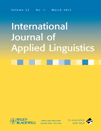
International Journal of Applied Linguistics
Elevating Multidisciplinary Dialogue in Language ResearchInternational Journal of Applied Linguistics, published by WILEY, is a premier platform for cutting-edge research in the field of applied linguistics. With a notable Impact Factor and ranked in the top Q1 quartile of linguistics and language, this journal serves as an essential resource for scholars, practitioners, and students. The journal’s wide-ranging scope includes various subfields such as language acquisition, language education, sociolinguistics, and discourse analysis, fostering multidisciplinary approaches to language studies. It has achieved a significant Scopus Rank, placing it in the 90th percentile for both Arts and Humanities as well as Social Sciences categories, reflecting its high visibility and influence in the academic community. The International Journal of Applied Linguistics is committed to advancing the understanding of language use in real-world contexts through rigorously peer-reviewed articles that contribute to both theory and practical applications. While it is not an open-access journal, it remains a highly respected publication for researchers looking to disseminate and acquire knowledge in applied linguistics.

Linguistic Research
Pioneering Innovations in the Study of LanguageLinguistic Research, published by the Kyung Hee University Institute for Study of Language & Information, stands as a prominent platform within the field of linguistics and language studies. With an ISSN of 1229-1374, this journal has gained recognition for its contributions to theoretical and empirical research since its inception in 2014. Ranked in the Q2 category of linguistics and language in 2023, it has established its presence in prestigious databases like Scopus, where it ranks #404 in Arts and Humanities and #479 in Social Sciences. The journal actively encourages scholarly discussion and innovation, providing a crucial venue for researchers, professionals, and students to disseminate their findings and engage in the evolving conversation around language. Despite not being open access, Linguistic Research is pivotal for those seeking comprehensive insights and advancements in linguistic studies, making it an essential resource for anyone passionate about the dynamics of language and communication.
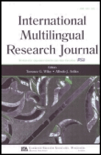
International Multilingual Research Journal
Unpacking the complexities of multilingualism in today's world.The International Multilingual Research Journal, published by Routledge Journals, Taylor & Francis Ltd, is a leading platform for the dissemination of innovative research in the fields of Education and Linguistics. With an impact factor reflecting its rigorous academic standards and a Q1 ranking in both relevant categories, this journal is dedicated to advancing the understanding of multilingualism and its implications globally. It serves as an essential resource for researchers, educators, and practitioners who seek to explore the complexities of language and learning across diverse cultural contexts. Since its inception in 2010, the journal has converged a wealth of scholarly articles that address contemporary issues in language use and pedagogical practices. The journal adheres to the highest research integrity standards and promotes open dialogue among scholars, making it a vital tool for those engaged in this expanding field. With its strong positioning in prestigious databases like Scopus, the International Multilingual Research Journal is committed to enriching the academic community and fostering interdisciplinary collaborations.
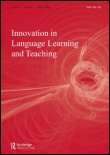
Innovation in Language Learning and Teaching
Elevating Pedagogy with Innovative Practices in Language Education.Innovation in Language Learning and Teaching is a premier peer-reviewed journal published by Routledge Journals, Taylor & Francis Ltd, focusing on the intersection of innovative practices in language education and teaching methodologies. With a notable impact factor reflected in its recent placement in the Q1 quartile for both Education and Linguistics and Language categories, this journal serves as a crucial resource for scholars and practitioners aiming to enhance pedagogical approaches and improve learning outcomes in language education. Spanning from 2009 to 2024, it showcases cutting-edge research that addresses contemporary challenges in the field, facilitating a deeper understanding of language acquisition, pedagogy, and curriculum development. The journal is indexed in Scopus, demonstrating its significant contribution to the academic community, with impressive ranks in both the Arts and Humanities as well as the Social Sciences categories. Although it follows a traditional subscription model, the journal is committed to disseminating high-quality research that fosters collaboration and discussion among researchers, educators, and students dedicated to advancing language learning and teaching practices.